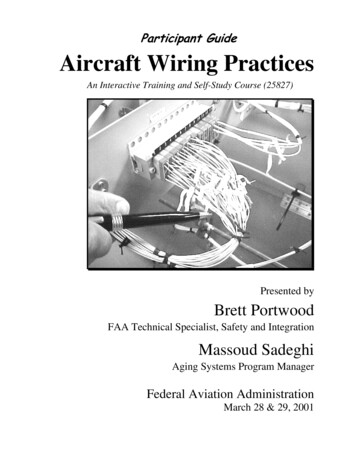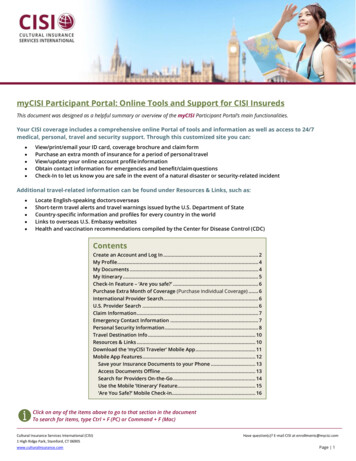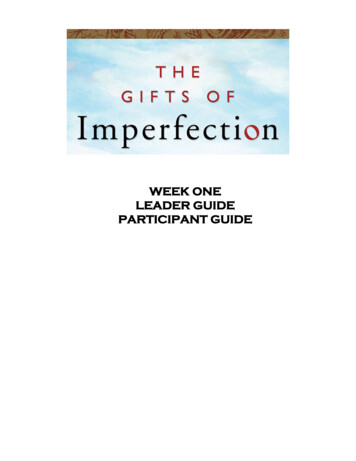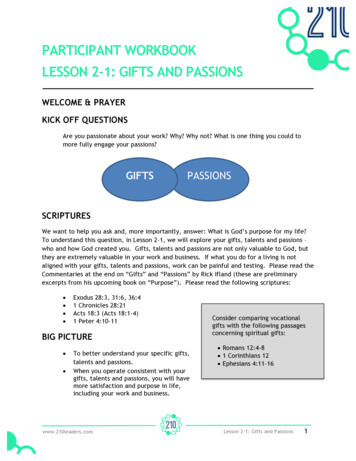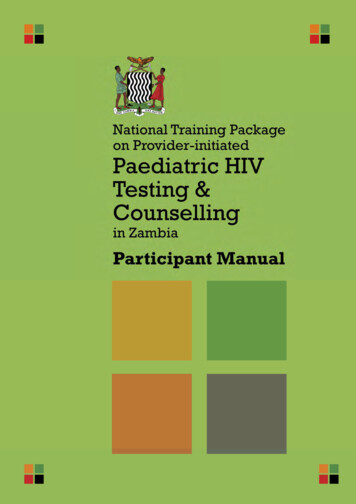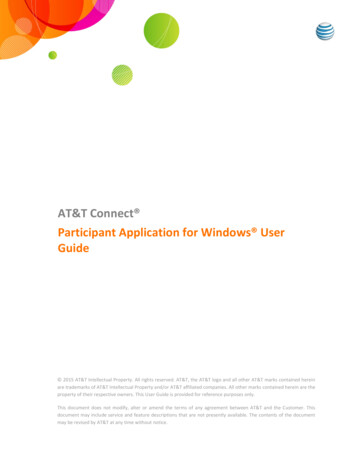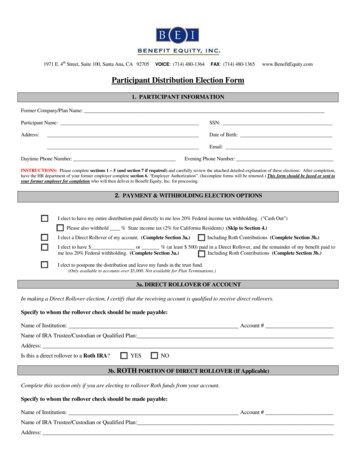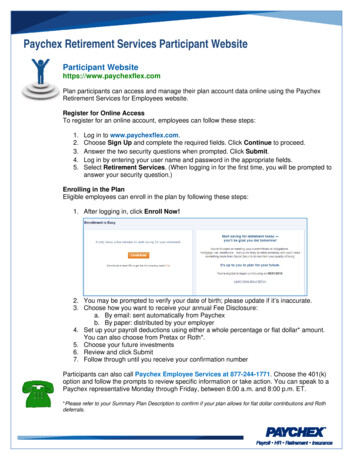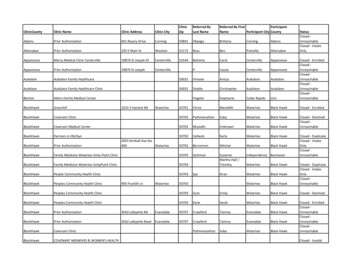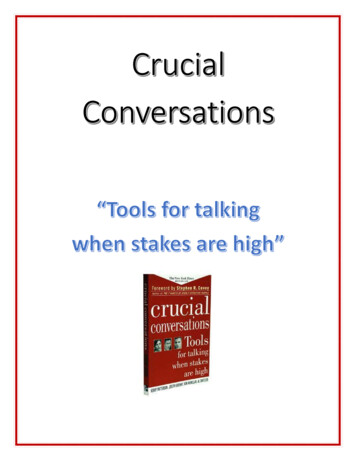
Transcription
Participant Preparation SheetThroughout the training you will have the opportunity to apply Crucial Conversations principles and skills to real life challenges you maybe facing. To make your training experience as beneficial to you as possible, you should come prepared with a few potential crucialconversations in mind that will help you fully apply the skills you will learn, and measure the effectiveness of the training.Part 1Consider some of the chronic problems or barriers you face in your relationships, teams, or organization. Use the following questionsto help you explore the possibilities. What bad results would you like to fix? What problem are you always trying to fix? What good results are you currently unable to achieve? What do people gripe about? What do people complain about at home and at work?Write down your lists for your professional life and your personal life (continue on other side as necessary).Chronic problems or barriers in my Professional LifeChronic problems or barriers in my Personal LifePart 2What are the moments when you experience some sort of challenge and know you need to respond in an appropriate, effectivemanner (like holding a productive conversation), but end up responding in a different way and doing less than your best? Write downyour lists of these crucial moments in your professional life and your personal life (continue on other side as necessary).Crucial Moments in my Professional LifeCrucial Moments in my Personal LifePart 3Now consider conversations in your professional life and personal life that you’re either dreading, or avoiding altogether, but if youlearned how to step up to and handle well, would improve results significantly. List them below (continue on other side as necessary).1.2.3.Bring this worksheet with you to your training to learn the principles and skills that will help you improve results and hold even yourmost difficult crucial conversation. 2008 VitalSmarts. All Rights Reserved.
Crucial Conversations AssignmentEveryone reads Chapters 1 & 2Read Chapter 1 – What’s a Crucial Conversation? And Who Cares?Read Chapter 2 – Mastering Crucial Conversations: The Power of DialogueYour Assigned Chapter –In your assigned group, read your group assigned Chapter. Be prepared to teach your assigned chapter to the class. You may choose to use visual aids and/or chart the following from page 214-216:o Chapter Principleo Skillo Crucial Question(s) After teach-back, be prepared to answer any questions. If no questions, have 1-2questions for class to confirm transfer of knowledge All group members must participate equally You will have 5 minutes to teach your assigned chapter and 2 minutes for Q&AInstructors will facilitate feedback and additional questions*DO NOT use Style Under Stress Assessment in your presentation*DO NOT use Jurassic Sales Call video in your presentation
WHAT IS YOUR STYLE UNDER STRESS ? From the New York Times bestsellerCrucial Conversations:Tools for TalkingWhen Stakes are HighHow do you react when conversations suddenly move from smoothand easygoing to tense or awkward? Do you retreat into silence? Do you go onthe attack? Or do you do your best to keep the conversation calm and focusedon the issues at hand?Crucial conversations take place when the stakes are high, opinions differ, andemotions run strong. Handling crucial conversations well can dramatically improveyour personal relationships, your career progress, and your work team’s performance.Take this 33-question test to explore how you typically respond when you’re inthe middle of a stressful situation. Have your friends, colleagues, or familymembers take the test as well. The answers may surprise you.A self-scoring version of this test is available online at www.vitalsmarts.com/styleunderstress. Information on what your score means can be found on pages68-69 of the New York Times bestseller Crucial Conversations: Tools for TalkingWhen Stakes are High.“When we usecrucial conversations skills,we can influence decisions,improve relationships,and speak our mindsin a way that gets heard.”- Joseph GrennyInstructionsBefore you start, read through the following points: RELATIONSHIPThink about the relationship you want to improve—with your boss, coworker, direct report, friend, or family member—and keep this relationship in mind. C IRCUMSTANCENext, think of a tough situation—one you might havehandled poorly or avoided altogether. A PPLYNow, with that situation in mind, respond to the statements onthe following pages as either true or false.
Style Under Stress Test TF1. At times I avoid situations that might bring me intocontact with people I’m having problems with.TF2. I have put off returning phone calls or e-mailsbecause I simply didn’t want to deal with theperson who sent them.TTTTTTTTFFFFFFFFTF13. When I’m discussing an important topic withothers, sometimes I move from trying to make mypoint to trying to win the battle.TF14. In the middle of a tough conversation, I often getso caught up in arguments that I don’t see howI’m coming across to others.TF4. When it comes to dealing with awkward orstressful subjects, sometimes I hold back ratherthan give my full and candid opinion.15. When talking gets tough and I do somethinghurtful, I’m quick to apologize for my mistakes.TF5. Rather than tell people exactly what I think,sometimes I rely on jokes, sarcasm, or snideremarks to let them know I’m frustrated.16. When I think about a conversation that took a badturn, I tend to focus first on what I did that waswrong rather than focus on others’ mistakes.TF6. When I’ve got something tough to bring up,sometimes I offer weak or insincere complimentsto soften the blow.17. When I’ve got something to say that others mightnot want to hear, I avoid starting out with toughconclusions, and instead start with facts that helpthem understand where I’m coming from.TF7. In order to get my point across, I sometimesexaggerate my side of the argument.18. I can tell very quickly when others are holdingback or feeling defensive in a conversation.TF8. If I seem to be losing control of a conversation,I might cut people off or change the subject inorder to bring it back to where I think it should be.19. Sometimes I decide it’s better not to giveharsh feedback because I know it’s bound tocause problems.TF9. When others make points that seem stupid to me,I sometimes let them know it without holding backat all.20. When conversations aren’t working, I step backfrom the fray, think about what’s happening, andtake steps to make it better.TF21. When others get defensive because theymisunderstand me, I immediately get us back ontrack by clarifying what I do and don’t mean.TF22. There are some people I’m rough on because, tobe honest, they need or deserve what I give them.3. Sometimes when people bring up a touchy orawkward issue I try to change the subject.10. When I’m stunned by a comment, sometimes Isay things that others might take as forceful orattacking—terms such as “Give me a break!” or“That’s ridiculous!”TF11. Sometimes when things get a bit heated I movefrom arguing against others’ points to sayingthings that might hurt them personally.TF23. I sometimes make absolute statements like “Thefact is ” or “It’s obvious that ” to be sure mypoint gets across.TF12. If I really get into a heated discussion, I’ve beenknown to be tough on the other person. In fact,they might even feel a bit insulted or hurt.TF24. If others hesitate to share their views, I sincerelyinvite them to say what’s on their mind, no matterwhat it is.
TF25. At times I argue hard for my view hoping to keepothers from bringing up opinions that would be awaste of energy to discuss anyway.TF26. Even when things get tense, I adapt quickly to howothers are responding to me and try a new strategy.TF27. When I find that I’m at cross purposes withsomeone, I often keep trying to win my way ratherthan looking for common ground.TF28. When things don’t go well, I’m more inclined to seethe mistakes others made than notice my own role.TF29. After I share strong opinions, I go out of my wayto invite others to share their views, particularlyopposing ones.TF30. When others hesitate to share their views, I dowhatever I can to make it safe for them to speakthonestly.TF31. Sometimes I have to discuss things I thought hadbeen settled because I don’t keep track of whatwas discussed before.TF32. I find myself in situations where people get theirfeelings hurt because they thought they wouldhave more of a say in final decisions than they endup having.TF33. I get frustrated sometimes at how long it takessome groups to make decisions because toomany people are involved.ScoringFill out the following score sheets. Each domain contains two tothree questions. Next to the question number is either a (T) or(F). For example, under “Masking,” question 5, you’ll find a (T). Ifyou answered question 5 true, check the box. With question 13,on the other hand, you’ll find an (F). Only check that box if youanswered the question false—and so on. Finally, add the numberof checks in each column to determine your total score.Your Style Under Stress score will show you which formsof silence or violence you turn to most often. Your CrucialConversations Skills score is organized by concept and chapterfrom the book Crucial Conversations: Tools for Talking WhenStakes are High so that you can decide which chapters willbenefit you the most. Again, a self-scoring version of this test isavailable at www.vitalsmarts.com/styleunderstress. Thistest is also duplicated on pages 63-69 of Crucial Conversations.Style Under StressYour silence and violence scores give you a measure of howfrequently you fall into these less-than-perfect strategies. It’sactually possible to score high in both. A high score (one or twochecked boxes per domain) means you use this technique fairlyoften. It also means you’re human. Most people toggle betweenholding back and becoming too gLabeling3(T)9(T)4(T)10 ( T )WithdrawingAttacking1(T)11 ( T )2(T)12 ( T )Silence TotalViolence Total
Crucial Conversations SkillsConclusionThe seven domains below reflect your skills in each ofthe corresponding seven skill chapters found in CrucialConversations: Tools for Talking When Stakes are High. If youscore high (two or three boxes) in one of these domains, you’realready quite skilled in this area. If you score low (zero or one),you may want to pay special attention to these chapters.Since these scores represent how you typically behave duringstressful or crucial conversations, they can change. Your scoredoesn’t represent an inalterable character trait or a geneticpropensity. It’s merely a measure of your behavior—and you canchange that.Here are two ways to improve your skills:Start with Heart(chapter 3)STATE My Path(chapter 7)13 ( F )17 ( T )19 ( F )23 ( F )25 ( F )29 ( T )TotalTotalLearn to Look(chapter 4)Explore Others’ Paths(chapter 8)14 ( F )18 ( T )20 ( T )24 ( T )26 ( T )30 ( T )TotalTotalMake It Safe(chapter 5)Move to Action(chapter 9)15 ( T )31 ( F )21 ( T )32 ( F )27 ( F )33 ( F )TotalTotalMaster My Stories(chapter 6)16 ( T )22 ( F )28 ( F )Total 2013 VitalSmarts. All Rights Reserved. VitalSmarts, the Vital head, Crucial Conversations, and Influencer Trainingare registered trademarks and Crucial Accountability and Change Anything are trademarks of VitalSmarts, L.C. ATTEND TRAININGCrucial Conversations is an award-winning, two-day coursethat teaches skills for fostering open dialogue around highstakes, emotional, or risky ining F REE NEWSLETTEROne of our best learning resources is our free, weeklye-newsletter. Subscribers of the Crucial Skills Newsletterreceive expert instruction from our bestselling authors onhandling real-life crucial conversations.www.crucialskills.com
ConversationPlannerUse the following worksheet to plan your next crucial conversation.Get Unstuck1. Where do you feel stuck (personally or professionally)?2. Unbundle with CPR. Identify:Content Issues:Pattern Issues:Relationship Issues:Which issue do you need to address, and with whom, in order to get unstuck?Start with Heart1. What do you really want:For yourself?For the other person?For the relationship?For the organization (if applicable)?Master My Stories1. What stories are you telling yourself about the situation or the person (Victim, Villain, Helpless)? 2014 VitalSmarts. All Rights Reserved.
2. Tell the rest of the story. Ask:a. What am I pretending not to notice about my role in the problem?b. Why would a reasonable, rational, and decent person do this?c. What should I do right now to move toward what I really want?STATE My Path1. Create a script for how you will begin the conversation. Start with facts, then tell your story, and be sure to end with a question thatinvites the other person into dialogue.THE FACTSMY STORYTHE QUESTION I’LL ASKMake It Safe1. What’s the worst possible response you could get with your crucial conversation?2. What safety skills would you use to address it (apology, contrast, create mutual purpose)?3. If the other person misunderstands your intent, what is a contrasting statement you could use?Don’t:Do:Explore Others’ Paths1. How could you use the “AMPP” (Ask, Mirror, Paraphrase, Prime) skills to help the other person come out of silence or violence?Move to Action1. How will you establish a way to follow up after the crucial conversation?Who:Will do what:By when:How we’ll follow up:
Crucial conversations take place when the stakes are high, opinions differ, and emotions run strong. Handling crucial conversations well can dramatically improve your personal relationships, your career progress, and your work team’s performance. Take this 33-question
